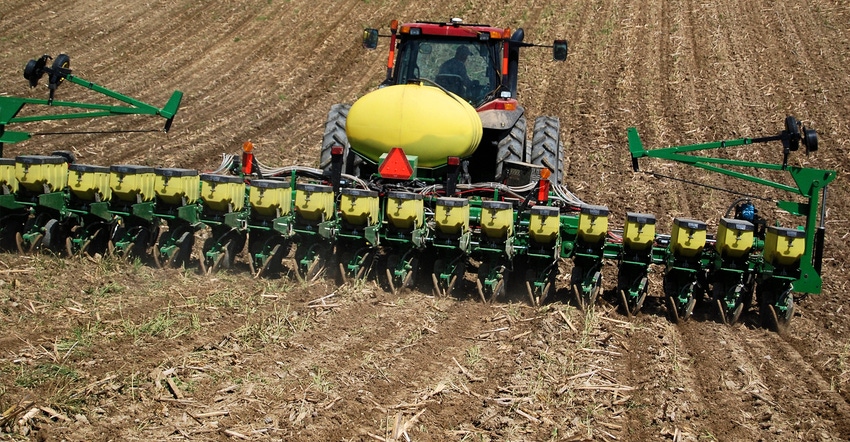
Okay, you’ve jumped up your planter size, added new high-speed planting tubes and hooked up to a bigger tractor. Now, you’re planting at 7 to 7 1/2 miles per hour, maybe even thinking of breaking the 10-mph speed limit, right?
Before you attempt that, check out what Indiana farmer Tom McKinney had to say about it: "You’d get too much wear and tear on your planter bouncing across the field." And, faster planting requires even more horses.
Pulling a 24-row planter, "we need a 310-horsepower tractor at 7 to 7 1/2 mph. We couldn’t even go at 8 1/2 to 9 mph and pull it right," McKinney says. Make sure you have enough horsepower to pull your planter faster, he says.
— Tom Bechman
Burndown herbicide basics
Chilly nights and cool cloudy days under 55 degrees F can dampen burndown herbicide performance, especially for glyphosate and in minimum-till and no-till fields. So consider these tips from Dwight Lingenfelter, Penn State Extension weed specialist:
• Glyphosate. Stick to recommend rates, whichever product you use. Use appropriate adjuvants (surfactant + ammonium sulfate) and reducing carrier volume to 10 gallons per acre to increase activity. AMS or other water softeners help alleviate hard water problems and reduce antagonism if tank-mixing with other herbicides, such as 2,4-D.
Be sure to add the AMS to the spray tank first. Then agitate before adding the glyphosate. If your water has a high pH (8 or greater), consider adding an acidifying agent.
Do not add 28% or 32% UAN or other fluid fertilizers. Avoid tank mixing with higher-rate (greater than 0.25 pound), clay-based herbicides (WDG, WG, DF, DG, F) like atrazine, simazine and metribuzin.
• Gramoxone SL. This contact paraquate-containing product is applied at 2 to 4 pints per acre. Apply 20 gallons of liquid carrier or more with flat fan nozzle tips, not flood jet tips. Include an appropriate nonionic surfactant.
Adding a triazine herbicide or UAN to the tank will boost burndown activity. Using UAN as a partial carrier will also increase the activity.
• 2,4-D ester. Remember, this is only for broadleaf control. Apply 1 pint between 7 to 14 days before planting or 3 to 5 days after planting for greater crop safety. Plant corn at least 1.5 inches deep.
Use ester formulations instead of amines. Esters are usually more effective under cool conditions, are less water soluble and are better on perennial weeds.
• Dicamba. Clarity, Banvel and other dicamba brands also are only for broadleaf weed control. Apply at up to 1 pint per acre on medium and fine textured soils with at least 2.5% organic matter. It can be tank-mixed with 2,4-D. But like 2,4-D, direct contact with corn seeds must be avoided. So plant corn at least 1.5 inches deep and apply 7 to 14 days ahead of planting or delay application until corn emerges.
Dicamba is often necessary for successful alfalfa or clover burndown. But do not use for soybeans in Pennsylvania.
Source: Penn State Extension
New dicamba sprayer cleaner
Monsanto and Adjuvants Unlimited have developed the first-ever ag sprayer system cleaner to deactivate dicamba and certain other pesticide active ingredients. It’s designed to be used within the rinse and cleanout processes specified on current dicamba product labels.
The product aims to help manage use of multiple herbicide systems, including the Roundup Ready Xtend Crop System, reports Ryan Rubischko, Monsanto dicamba portfolio lead. It’s scheduled to be available this spring through distributors under the product name to be released in May.
Source: Monsanto
Pennsylvania eases high tunnel regulations
Farmers in the Keystone State no longer need to worry about submitting stormwater management plans for high tunnel structures. Gov. Tom Wolf recently signed into law provisions exempting high tunnels from state regulations intended for commercial and residential development.
"This is a victory for farmers who are helping to meet increased consumer demand for locally-grown fresh fruits and vegetables," notes Rick Ebert, Pennsylvania Farm Bureau president. Many farmers held off assembling the temporary structures due to uncertainty over how they would be regulated and the cost, time and paperwork involved in meeting stormwater management standards.
"The overall cost of putting together a stormwater management plan for a high-tunnel structure would have likely eliminated or significantly negated the profitability of using the high tunnel in the first place," Ebert says. "The new law should remove those obstacles and benefit local consumers."
Source: Pennsylvania Farm Bureau
About the Author(s)
You May Also Like




